Imagine a citywide biennial in New York, spread out across the boroughs in dozens of different venues, requiring a trip through all the boroughs, changing trains to get from Harlem to Bushwick—that’s what Prospect is like. Except it’s in New Orleans. Regardless, having to put forth so much effort can be taxing.
Now, if you think positive, it’s an errant treasure hunt for art. If you’re the glass is half empty-type, you’ll feel like you’re in art-tourist hell. Must. See. Every. Thing.
Prospect has too much to cover in just one slideshow. Today’s slideshow will cover the New Orleans Museum of Art’s Prospect exhibitions, one curated by Prospect staff, then another curated by NOMA, thereby relegating it to “P.3+” status. (P.3+ refers to all events taking place during Prospect, but curated by individuals outside of the organization. Many local exhibitions at museums and galleries got this designation.)
The official Prospect exhibition, in one soundbite: Like Massimiliano Gioni’s 2013 Venice Biennale, the curation leans towards mixing historically under-recognized artists with younger ones.
And for the unofficial Prospect exhibition, Reparation: It has more local artists in it than any other exhibition affiliated with Prospect (hundreds), made possible through the inclusion of small-scale work.
More to come this week.
New Orleans Museum of Art
During the press preview, Artistic Director Franklin Sirmans mentioned that if there were one single place to begin your Prospect journey, NOMA would be it. He’d centered the exhibition around ideas of the self and other (see Paddy Johnson’s review), often in relation to art from history past, and brought up Paul Gauguin’s painting “Where Do We Come From? What Are We? Where Are We Going?” as a touchstone. This, one of Gauguin’s most well-known Tahitian-era paintings, features a life-cycle of sorts; it begins on the right-hand side with an infant, the apex represented by pulling fruit off a tree (of life), and ends with the figure of a crumpled, elderly woman. Though figuring prominently in Prospect texts, Prospect didn’t have that painting; it belongs to the Boston MFA.
For one, you could find another Gauguin. And that’s just what Prospect did, receiving a different, and altogether smaller, Tahitian-inspired work, “Under the Pandanus (I Raro te Oviri),” on loan from the Dallas Museum of Art. It has much less of the existential “oomph” from the original reference. Not a bad painting, but it lacks the emphasis on the life cycle—its main figures are a young man and woman, and a dog—as well as the epic quality of having as many characters as a Tolstoy novel.
Like this Gauguin piece, many of the biennial’s other historical inclusions (Rodin, Tarsila do Amaral) are already integrated within the museum’s collection. As such, you’ve gotta hunt down Prospect works within the museum. That could be a noble curatorial conceit, making ties between the imported, international work at Prospect and artworks that have been home to this museum for decades upon decades. Can’t you just imagine a world where New Orleanians rejoice in this cultural inclusion?
What actually happened led to a stultifyingly difficult map provided by visitor services that marked Prospect artworks with black dots. According to the black dot, it looked like the Rodin was included in the Prospect exhibition. You honestly couldn’t tell based on the map.
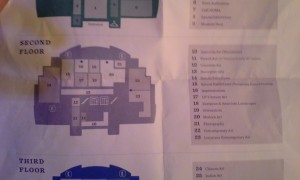
Sorry for the awful picture on my phone of the dots. The dots are how you’d know what’s in Prospect.3.
As such, it seemed like the first Prospect work you’d encounter at NOMA is this sassy-looking Rodin in the foyer, about to sashay off its pedestal. No identification adorned the wall label that this was a work in Prospect, though, not even the bright pink Prospect stickers found all throughout NOLA. So again, you just couldn’t be sure about what’s Prospect or not.
Aside from the historical works scattered about, there was a gallery devoted to Prospect works brought into the museum: Jeffrey Gibson, Huguette Caland, Ed Clark, among others.
I did like this little guy by Choctaw-Cherokee artist Jeffrey Gibson (who lives in Brooklyn). I’m just really into hybrids, and how sci-fi can inform new ways of visualizing the future, i.e. Afrofuturism and Sun Ra. I can’t say I know what the future holds for this little guy, though. Situating the spaceman on a pedestal doesn’t really say much about his potential, though.
If there’s one thing you should know about this Biennial, the diaspora is on view. It’s the most diverse than most contemporary art exhibitions, museums or elsewhere. Diversity wasn’t an overt part of Sirman’s theme, exactly, but it’s hard not to see that internationalism was a goal—it was everywhere. Regardless, the work was generally hit or miss.
And, as mentioned with the 2013 Venice Biennale, there’s a handful of historically under-recognized artists (who may or may not have any relationship to New Orleans). Lebanese artist Huguette Caland, born in 1938, is the sentimental, figurative painting equivalent to Gioni’s Maria Lassnig. Less violent, but equally psychological as Lassnig’s paintings, “Sunrise” has a curious brown shape that sometimes looks like hair belonging to the figure whose eye is showing; at other times, the shape looks like shadow of a nose belonging to a third figure who has disappeared under the paint. This type of visual play lets you know your mind is at work at the same time as the eyes; Caland’s work initiated one of the few moments at NOMA when I felt that way.
Down the hall from that Prospect exhibition lay Reparation, a P.3+ exhibition. That exhibition was the the best way to get a sense of who’s living and making work in New Orleans—from Mel Chin to Miss Pussycat. Of course, Reparation only allows a glimpse of that: the exhibition shows 187 works made by artists in the city, each artist having made work that would fit on a 4 x 4 and 3/4”canvas. The New Orleans Museum of Art has been putting on this local project for the last ten years.
Reparation, like other P.3+ events, was one of the only events driven by local curators and made possible with the help and sweat of artists living in New Orleans. Maybe next time these shows will get more of an acknowledgement than a “+”? Without them, there just wouldn’t be much new art to see from artists in the city.

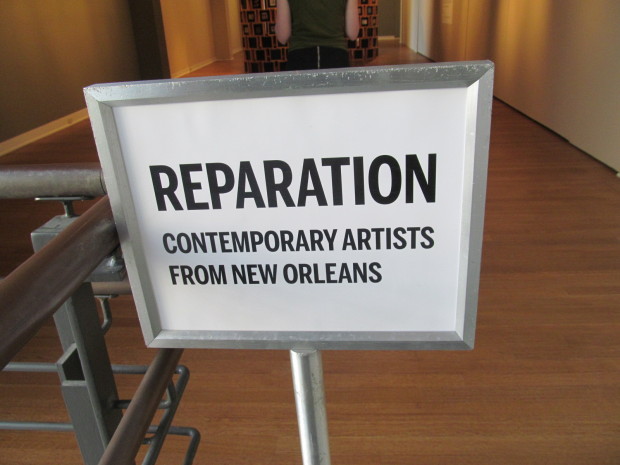
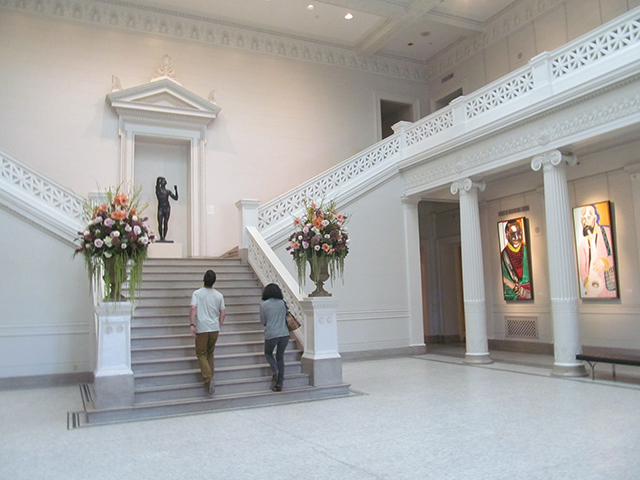
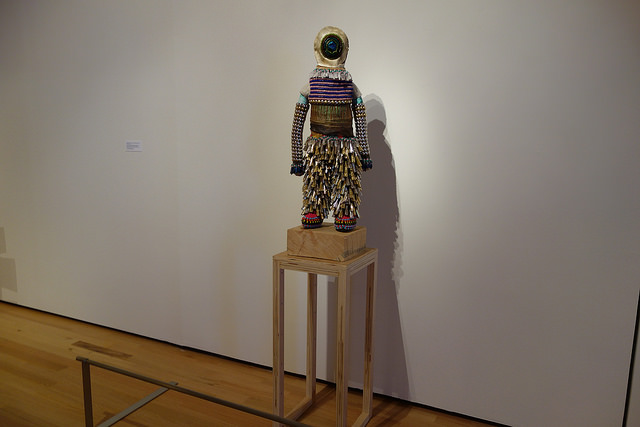

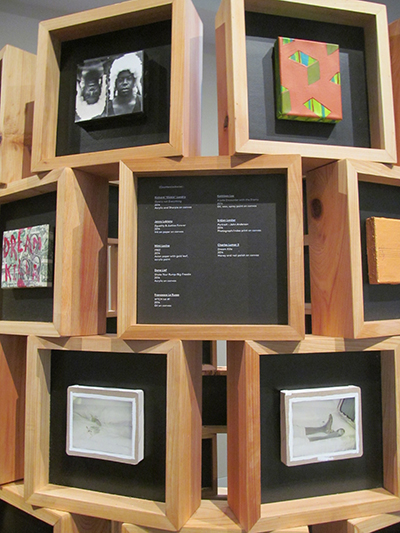

Comments on this entry are closed.